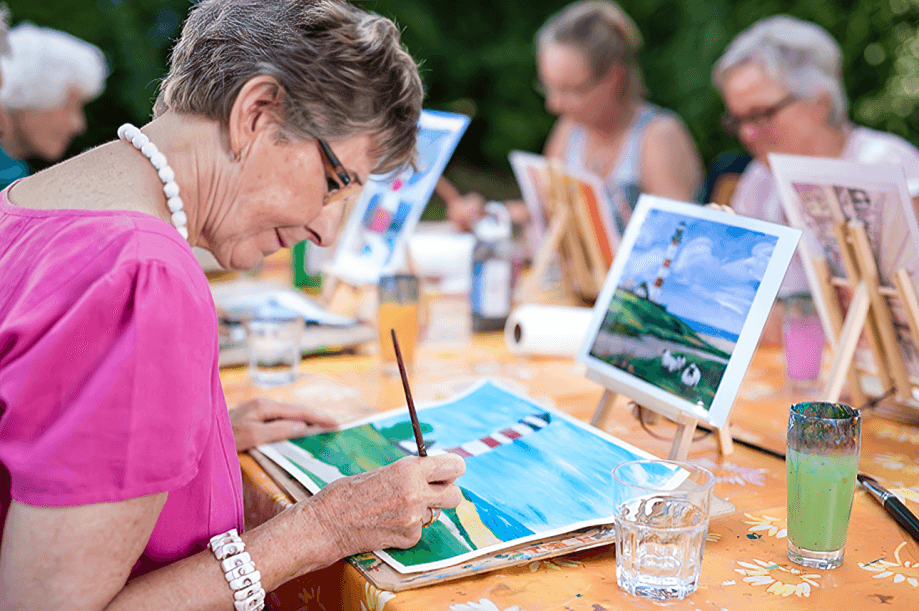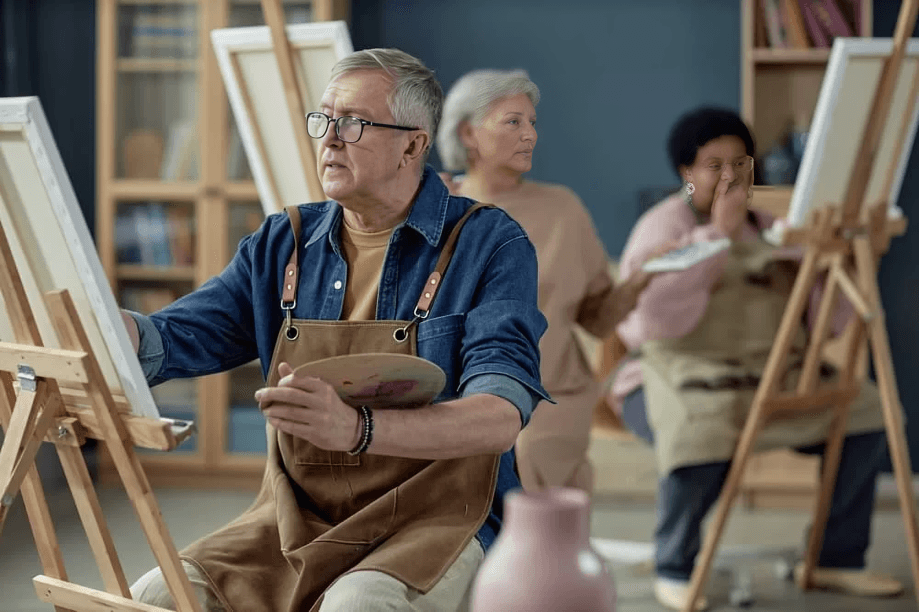
“
Art therapy for seniors: benefits & activities is a powerful approach to aging well through creativity. Whether painting, sculpting, or drawing, this form of therapy improves mood, sharpens memory, relieves stress, and promotes connection with others. Art becomes more than a hobby—it becomes healing. Embracing Art Therapy for Seniors.1
1
”
Seniors using art therapy often show improved memory and focus. Engaging the brain in visual and tactile tasks stimulates neural activity and delays cognitive decline, especially in those with early dementia. 1
Creating art helps older adults express feelings they may not communicate verbally. This non-verbal release lowers anxiety and supports emotional healing, especially during life transitions or after loss. 2
Studies show painting or sculpting reduces cortisol, the body’s stress hormone. Seniors involved in art therapy report feeling calmer, with lower blood pressure and improved heart rate regulation. 3

Art therapy sessions in senior care facilities encourage social interaction. Group projects and shared artistic goals strengthen bonds, easing loneliness and building a sense of belonging among peers.
Regular art-making boosts hand-eye coordination and fine motor skills. For seniors with arthritis or mobility issues, repetitive brushstrokes or clay molding can gently strengthen muscles and improve dexterity. 4
Personalized art projects in therapy promote independence and confidence. When seniors complete a piece, they feel a sense of accomplishment, reinforcing their ability to make choices. 5
Therapists tailor art activities to individual needs. Watercolor may soothe someone with anxiety, while collage might help another process complex memories. Art therapy adapts to emotional and physical conditions. 6
Alzheimer’s patients participating in art therapy show more positive moods and fewer aggressive behaviors. Art-making allows them to communicate visually, even when words become difficult or disappear. 7
Seniors in palliative care benefit greatly from art therapy. Creating art provides comfort, dignity, and a chance to leave behind meaningful pieces for loved ones—a final act of self-expression. 8

Art therapy is linked to improved sleep quality in older adults. Relaxing creative sessions can calm the mind, regulate mood, and help reduce nighttime anxiety and sleep disturbances.
Engaging in collaborative mural or group art fosters teamwork and mutual respect among seniors. It strengthens community dynamics and gives participants a sense of shared purpose and pride. 9
Caregivers benefit, too—watching a loved one blossom through art can ease caregiver stress and deepen the emotional connection between family members and seniors. 10
Seniors dealing with grief after losing a spouse often find comfort in art therapy. Visual expression becomes a tool to honor memories and navigate the complex process of mourning. 11
Veterans in senior years often use art therapy to process trauma. It becomes a therapeutic outlet for expressing emotions tied to combat experiences in a safe, structured, and symbolic way. 12
Seniors from diverse cultures often incorporate traditional artistic styles into therapy. This cultural inclusion promotes pride, identity, and connection with heritage, enriching the experience of creative healing. 13

Digital art therapy is emerging for tech-savvy seniors. Tablets and styluses open doors for those with limited mobility, allowing participation in artistic expression through modern means.
Music, poetry, and visual art can be combined in mixed-media therapy. Seniors respond well to this blend, which stimulates multiple senses and deepens emotional engagement in therapy sessions. 14
Seniors in rural or isolated areas benefit from virtual art therapy programs. These online sessions combat loneliness and provide access to mental health support through creative means. 15
Coloring mandalas, a structured form of art therapy, promotes mindfulness in older adults. This repetitive, symmetrical art form centers the mind and reduces agitation, especially in memory care settings. 16
Psychiatrist Carl Jung viewed creative expression as essential to understanding the self. His belief that “the hands can solve a mystery that the intellect cannot” aligns with art therapy’s core purpose for seniors. 17


